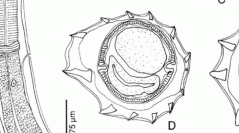

 Zoosystema
20 (1) - Pages 23-30
Zoosystema
20 (1) - Pages 23-30Two new species belonging to the Nippostrongylinae (Heligmosomoidea, Heligmonellidae) are described. Neoheligmonella skirringi n.sp. and N. mastomysi n.sp. are both parasites of Mastomys erythroleucus from the Republic of Senegal (Province of Casamance). Among the species belonging to the genus Neoheligmonella, N. bainae Durette-Desset et Cassone, 1970 parasitic in Steatomys opimus from Burkina Faso, N. tranieri Durette-Desset et Cassone, 1986, parasitic in Uranomys ruddi from the Ivory Coast, and the two new species have the following characters: (1) carene of average development; (2) gradient in the size of the dorsal crests which is very slight or absent; (3) caudal bursa with rays 2 and 3 of equal length to that of rays 5 and 6. N. tranieri differs from N. skirringi and N. mastomysi in the absence of the carene at the mid-body level. N. bainae differs from N. skirringi in the presence of six ventral vs eight ridges and a well developed prevulval synlophe. It differs from N. mastomysi in that there is a symetrical origin of rays 8 on the dorsal ray, rays 9 are hook-shaped and the genital cone is well developed. N. skirringi and N. mastomysi are differentiated from each other by the number of cuticular ridges, the position of the excretory pore, the origin of rays 8 on the dorsal ray, the prevulval synlophe and the number of rows of eggs in the uterus. The two species, although found in neighbouring regions do not occur together in the same individual host but in each area the prevalences species are similar.
Neoheligmonella skirringi n.sp., Neoheligmonella mastomysi n.sp. Nematoda, Trichostrongylina, Nippostrongylinae, Muridae, rodents, Senegal.